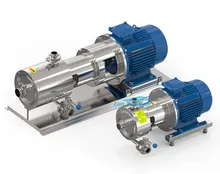Stainless Steel SS304 SS 316 Sanitary Rotary Lobe Pump
Lobe Rotary Pump features mainly include the following points

A Rotary Pump is a pump that delivers liquids through rotational motion. During rotation, the main part of the pump (usually called the pump casing) remains stationary while the internal components of the pump (usually two or more rotors) rotate within the pump casing, pushing liquid from the inlet to the outlet. .
Specifically, the main working principle of the Rotary Pump is to form a sealed cavity through the rotation of the rotor, thereby transporting liquid from the suction cavity to the pressure out cavity. The delivery efficiency of this type of pump is usually relatively high and can be adapted to a variety of different working environments.
The main features of Rotor Pump include the following points

1. Simple structure: The structure of the rotary pump is relatively simple, mainly consisting of a crankshaft, a piston or plunger, a pump casing, a suction and discharge valve, etc. This structure makes the manufacturing and maintenance of the pump more convenient, and at the same time ensures the stability of the pump.
2. Easy maintenance: The maintenance of the rotary pump is relatively simple. Because the structure is relatively intuitive, once a fault occurs, the problem can be found more easily and repaired. At the same time, because the pump has fewer parts, maintenance time and cost are relatively low.
3. Wide range of applications: Rotary pumps can transport a variety of different liquids, including high-viscosity, high-concentration liquids, and even difficult liquids such as suspended slurries containing particles. This wide range of applications allows rotary pumps to be used in many fields.
4. Stable performance: The performance of the rotary pump is relatively stable. Due to the structural design and material selection, the pump can maintain stable performance when transporting liquid and is not prone to failure or performance fluctuations.
5. Strong reversibility: The rotary pump can be reversed, which allows the pump to play an important role in situations where the pipeline needs to be flushed in the reverse direction. This reversibility provides more flexibility in design, use and maintenance.
The materials in which the Rotary Lobe Pump is made may vary based on different designs and application scenarios, but generally include the following materials:
1. Metal materials: such as stainless steel, aluminum alloy, cast iron, etc., used to manufacture key components such as pump bodies, rotors, seals, etc., to meet requirements such as corrosion resistance, wear resistance, high strength, and high precision.
2. Non-metallic materials: such as polymers, ceramics, glass, etc., used to manufacture pump wearing parts and seals to meet specific chemical compatibility and sealing performance requirements.
3. Food-grade materials: For example, polymer materials that meet FDA standards are used to manufacture pump components in the food and pharmaceutical processing industries to ensure that they are non-toxic, odorless, and do not contaminate the transported media.
When designing a Rotary Lobe Pump, the type and specification of materials required should be determined based on the specific application and media characteristics. At the same time, it is also very important to choose the appropriate material combination and manufacturing method, taking into account factors such as manufacturing process, cost and service life.
rotary lobe pump application
The rotary pump can transport difficult liquids such as suspended slurries with high concentration, high viscosity, and particles. The liquid can be reversed and is suitable for situations where pipelines need to be flushed in the reverse direction. At the same time, the pump has stable performance, easy maintenance, and wide range of applications. It is widely used in material transportation, pressurization, spraying and other fields in various industrial fields.
Rotor Pumps Table of technical parameters

| outlet | ||||||
| Type | Pressure | FO | Power | Suction pressure | Rotation speed | DN(mm) |
| (MPa) | (m³/h) | (kW) | (Mpa) | rpm | ||
| RLP10-0.1 | 0.1-1.2 | 0.1 | 0.12-1.1 |
0.08 |
10-720 | 10 |
| RLP15-0.5 | 0.1-1.2 | 0.1-0.5 | 0.25-1.25 | 10-720 | 10 | |
| RP25-2 | 0.1-1.2 | 0.5-2 | 0.25-2.2 | 10-720 | 25 | |
| RLP40-5 | 0.1-1.2 |
2--5 |
0.37-3 | 10-500 | 40 | |
| RLP50-10 | 0.1-1.2 | 5月10日 | 1.5-7.5 | 10-500 | 50 | |
| RLP65-20 | 0.1-1.2 | 10--20 | 2.2-15 | 10-500 | 65 | |
| RLP80-30 | 0.1-1.2 | 20-30 | 3--22 | 10-500 | 80 | |
| RLP100-40 | 0.1-1.2 | 30-40 | 4--30 |
0.06 |
10-500 | 100 |
| RLP125-60 | 0.1-1.2 | 40-60 | 7.5-55 | 10-500 | 125 | |
| RLP150-80 | 0.1-1.2 | 60-80 | 15-75 | 10-500 | 150 | |
| RLP150-120 | 0.1-1.2 | 80-120 | 11-90 |
0.04 |
10-400 | 150 |
Products categories
-

E-mail
-

Phone
-

Top





 0086 15800211936
0086 15800211936





